Flecktarn
| Flecktarn | |
|---|---|
|
Modern German Flecktarn introduced 1990 | |
| Type | Military camouflage |
| Place of origin |
|
| Service history | |
| In service | 1990–present |
| Used by | See below |
| Wars |
Bosnian War (1992-1995) Afghanistan War (2001-present) Iraq War (2003-present) |
| Production history | |
| Designed | 1976 |
| Variants | See below |

Flecktarn (German pronunciation: [ˈflɛktaʁn]; "mottled camouflage"; also known as Flecktarnmuster or Fleckentarn) is a family of 3-, 4-, 5- or 6-color disruptive camouflage patterns, the most common being the five-color pattern, consisting of dark green, light green, black, red brown and green brown or tan depending on the manufacturer. The original German 5-color pattern was designed for use in European temperate woodland terrain. A 3-color variation called Wüstentarn is used for arid and desert conditions and has been used by the German Bundeswehr in Afghanistan.
The original German 5-color flecktarn has been adopted, copied and modified by many countries for their own camouflage patterns.
History
The German Army started experimenting with camouflage patterns before World War II, and some army units used Splittermuster ("splinter pattern") camouflage, first issued in 1931.[1] Waffen-SS combat units used various patterns from 1935 onwards. Many SS camouflage patterns were designed by Prof. Johann Georg Otto Schick.
- Platanenmuster ("Plane tree pattern"; 1937–1942): spring/summer and autumn/winter variations
- Rauchtarnmuster ("smoke pattern"; 1939–1944): spring/summer and autumn/winter variations
- Palmenmuster ("palm tree pattern"; circa 1941–?): spring/autumn variations
- Beringtes Eichenlaubmuster ("oak leaf B"; 1942–1945)
- Eichenlaubmuster ("oak leaf A"; 1943–1945): spring/summer and autumn/winter variations
- Erbsenmuster ("pea dot"; 1944–1945): Originally meant to replace all other SS camouflage patterns
- Leibermuster (1945)
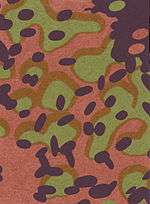 Platanenmuster pattern (summer side) in an early version from 1937
Platanenmuster pattern (summer side) in an early version from 1937 Platanenmuster pattern (autumn side) in an early version from 1937
Platanenmuster pattern (autumn side) in an early version from 1937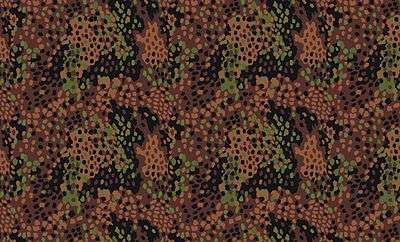 Erbsenmuster pattern version from 1944
Erbsenmuster pattern version from 1944
Modern Flecktarn
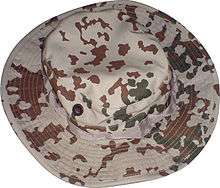
In 1976, the Bundeswehr in Germany developed a number of prototype camouflage patterns, to be trialled as replacements for the solid olive-grey "moleskin" combat uniform. At least four distinct camouflage patterns were tested during Bundeswehr Truppenversuch 76 ("Bundeswehr Troop Trial 76"). These were based on patterns in nature:[1] one was called "Dots" or "Points"; another was called "Ragged Leaf" or "Saw Tooth Edge"; another was based on pine needles in winter.[1]
Designed by the German company Marquardt & Schulz, several patterns were developed and tested by the German military. The pattern named "Flecktarn B" was chosen as the final pattern for use. The word flecktarn is a composite formed from the German words Fleck (spot, blot, patch or pattern) and Tarnung (camouflage). The Bundeswehr kept its green combat dress throughout the 1980s, however, while trials were conducted. Flecktarn was only widely introduced in 1990 in a newly reunited Germany.[1]
In Germany, the Flecktarn camouflage pattern is used by all Bundeswehr service branches, the Heer (army), the Luftwaffe (air force), some Marine (navy) units and even the Sanitätsdienst (medical service). It is also used by snipers of the Österreichisches Bundesheer (Federal Army of Austria) and Belgian Air Force ground personnel and airborne infantry. France tested Flecktarn for use, but rejected it; the Dutch army also tested and rejected it, allegedly because it was "too aggressive".[1] Flecktarn was seen as controversial because of its resemblance to the Waffen-SS "peas" and "oak leaves" patterns, which also used dots in various colors.[1]
Variants
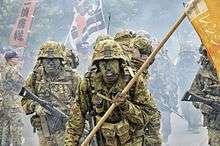
Flecktarn is the basis for the Bundeswehr's Tropentarn desert camouflage,[2] the Danish military's T/78 and M/84 camouflage, including a desert variation of the Danish pattern. Several variations of the Flecktarn camouflage are also used by the Russian military, one is called Sever (Russian for "north"), sometimes also referred as Flectar-d. Another variant is called Tochka-4. Other country variations include Japan's Type II Camouflage; Type 03 Plateau camouflage, used by the Chinese military in Tibet (and some Russian Special Forces); and an urban variation used by some police units in Poland.[3] Albania used a 5-color German flecktarn while participating in IFOR in Bosnia in 1996.[4]
In 2013, the German company Mil-Tec introduced a new version of Flecktarn, called the Arid Flecktarn. It retains the 5-color pattern but with the colour scheme resembling that of MultiCam.[5] It remains a commercial variant and is not in use by any world military.
 Chinese Tibetarn
Chinese Tibetarn Belgian Flecktarn
Belgian Flecktarn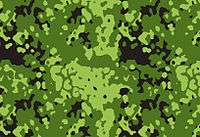

 French Experimental Desert Flecktarn
French Experimental Desert Flecktarn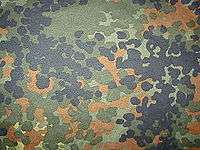 German Flecktarn
German Flecktarn German Tropentarn
German Tropentarn Indian Flecktarn
Indian Flecktarn Japanese Jieitai
Japanese Jieitai Japanese Winter Jieitai
Japanese Winter Jieitai Japanese Desert Jieitai
Japanese Desert Jieitai Polish Urban Flecktarn
Polish Urban Flecktarn
wz AT 1 PLAMIAK Polish Woodland Flecktarn
Polish Woodland Flecktarn
Gepard Russian Flectar-D
Russian Flectar-D Commercial Arid Flecktarn
Commercial Arid Flecktarn Commercial Schneetarn
Commercial Schneetarn
References
- 1 2 3 4 5 6 Newark, Tim (2007). Camouflage. Thames and Hudson. pp. 133–134, 157. ISBN 978-0-500-51347-7.
- ↑ "Uniformen der Bundeswehr" (in German). Bundeswehr. Retrieved 22 August 2016.
- ↑ SZOŁUCHA, BARTOSZ. "New Uniforms for Metro PD". special-ops.pl (in Polish). MEDIUM Group. Retrieved 22 November 2016.
- ↑ "Albania". SFOR Informer Online. NATO. Retrieved 27 March 2016.
- ↑ "M/84 Camouflage Version of MultiCam Could Have Looked Like This". Krigeren.dk (in Danish). Retrieved 21 January 2016.
External links
| Wikimedia Commons has media related to Flecktarn. |
